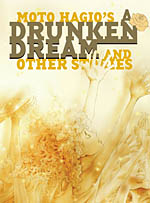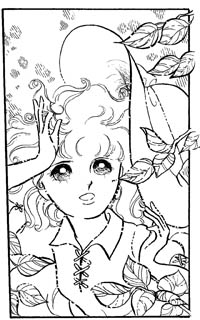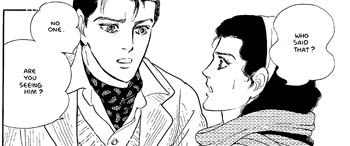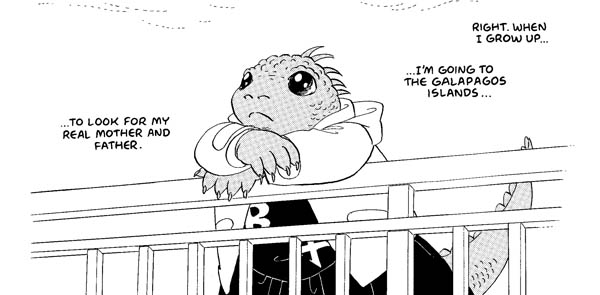 By Moto Hagio
By Moto Hagio
288 pages, black and white, with some color
Published by Fantagraphics
I never did read the issue of The Comics Journal that interviewed Moto Hagio, and printed one of her stories in English. I understand that it was that issue that convinced the rest of Fantagraphics to publish a "best-of" collection of Hagio’s work, though, and that it talked a great deal about her importance in helping define the shôjo ("girl’s comics") genre in Japan. Here’s what I do know, though. Going into A Drunken Dream and Other Stories blindly, it’s ultimately a book that sucked me into its stories and made me want to read a lot more of Hagio’s comics. A mixture of romance, science-fiction, and family drama, these ten story compilation is one of the strongest examples I’ve seen of the depth and breath that the shôjo genre can contain.
 Collected in order from oldest to newest, A Drunken Dream and Other Stories gets off to a slightly slow beginning. The opening story "Bianca" reminds me in some ways of the gothic novels of writers like Jane Austen, the Brontë sisters, and Daphne du Mariner, with its hidden family drama, misunderstandings, and tragedy looming over the entire piece. It’s not a bad story, but it (more than anything else in A Drunken Dream and Other Stories) feels curiously old-fashioned, no doubt due to being the oldest piece in the book. It’s a sentiment that’s shared in the third story, "Autumn Journey," but it’s almost fun to compare the two to see how much Hagio has already improved in her craft. In both "Bianca" and "Autumn Journey," we’re told the story through an outsider, observing the focus of the piece, but "Autumn Journey" gets inside Johann’s head so much more than Bianca, fleshing him out and giving the reader a much stronger emotional connection to the overall piece. The story itself is also slightly more gripping, providing a much stronger raison d’être in general.
Collected in order from oldest to newest, A Drunken Dream and Other Stories gets off to a slightly slow beginning. The opening story "Bianca" reminds me in some ways of the gothic novels of writers like Jane Austen, the Brontë sisters, and Daphne du Mariner, with its hidden family drama, misunderstandings, and tragedy looming over the entire piece. It’s not a bad story, but it (more than anything else in A Drunken Dream and Other Stories) feels curiously old-fashioned, no doubt due to being the oldest piece in the book. It’s a sentiment that’s shared in the third story, "Autumn Journey," but it’s almost fun to compare the two to see how much Hagio has already improved in her craft. In both "Bianca" and "Autumn Journey," we’re told the story through an outsider, observing the focus of the piece, but "Autumn Journey" gets inside Johann’s head so much more than Bianca, fleshing him out and giving the reader a much stronger emotional connection to the overall piece. The story itself is also slightly more gripping, providing a much stronger raison d’être in general.
It’s in the second story, "Girl On Porch With Puppy," that we also start to see a different side to Hagio’s writing. It’s a story that’s hard to discuss without giving away the punch line (and doing so ruins the impact of the piece in general), but it’s almost playful in its deliberate unpredictable nature. She’s quietly switching some of the genre elements of her story, and while it’s in many ways just a "gotcha!" story, coming so early in A Drunken Dream and Other Stories gives it a nice element of surprise and serves as a warning to the reader: do not assume that you know what you are in for when reading this book.
The fourth story, "Marié, Ten Years Later," is probably the closest thing A Drunken Dream and Other Stories has to a dud. It’s not bad, but it feels remarkably predictable and slightly too easy. By this point it’s becoming clear that Hagio’s stories will rarely have a simple solution, but here we get just that. Even with the face of tragedy being presented to the reader, it’s hard to shake the feeling that somehow this is a "happy" ending of sorts. This is the only story where you might find yourself wishing for a slightly greater punch at the end, and it’s a little disappointing. The one noteworthy thing about "Marié, Ten Years Later" is that it’s where we first begin to see Hagio’s art style change. Up until now it’s been a very crisp, clear, unencumbered series of character designs. It’s a style that many years later Colleen Doran made popular in the United States, with open faces and flowing, curly hair, but in "Marié, Ten Years Later" we’re starting to see more detail and richness enter Hagio’s art.
 That’s an evolution that continues into the first color story, "A Drunken Dream." Here Hagio goes full-force into a science-fiction story of romance, death, and gender exploration. It’s a lush story, both in art and writing, and in some ways it’s almost hard to believe it’s by the same author as the much simpler "Bianca." "A Drunken Dream" uses deep red hues to bring not only the clouds of Jupiter, but people’s clothing and hair to life. The colors at times look almost airbrushed on, a gentle mist that permeates the page and makes you slightly nervous about touching the paper. It’s fitting for such an epic, larger than life story; while I found it hard to relate to the characters, that’s ultimately not a problem. It’s engrossing in its tragedy, and it’s here that you begin to truly understand the depth of Hagio’s vision.
That’s an evolution that continues into the first color story, "A Drunken Dream." Here Hagio goes full-force into a science-fiction story of romance, death, and gender exploration. It’s a lush story, both in art and writing, and in some ways it’s almost hard to believe it’s by the same author as the much simpler "Bianca." "A Drunken Dream" uses deep red hues to bring not only the clouds of Jupiter, but people’s clothing and hair to life. The colors at times look almost airbrushed on, a gentle mist that permeates the page and makes you slightly nervous about touching the paper. It’s fitting for such an epic, larger than life story; while I found it hard to relate to the characters, that’s ultimately not a problem. It’s engrossing in its tragedy, and it’s here that you begin to truly understand the depth of Hagio’s vision.
"Hanshin: Half-God" was the story printed in the all-shôjo issue of The Comics Journal, but I’m glad I hadn’t read it until now. Experiencing it for the first time here was the perfect next step forward from "A Drunken Dream," taking big ideas and concepts like that story did, but watching Hagio now boil them down into a much more intimate, personal story about conjoined twins Yudy and Yucy and the relationship between the pair. Narrated entirely by Yudy, "Hanshin: Half-God" is a story that on the surface would be impossible to fully comprehend by almost all readers, but the reality is something entirely different. Hagio isn’t really telling a story about conjoined twins, but rather about the bonds of family and what we take for granted until it’s gone. Yudy’s movement from one end of the pendulum to the other is sad and distressing, no matter if she’s at the "good" or "bad" side of the scales. It’s an engrossing story from start to finish, and Hagio’s art is up to the task of bringing this pair of "ugly" and "beautiful" sisters to life. As Yudy reflects on what’s happened throughout this story, the sadness in her eyes is almost unbearable. I can see why "Hanshin: Half-God" grabbed people’s attention so strongly after being printed in The Comics Journal, and it’s a strong reminder of just how large the shôjo genre really is.
 "Angel Mimic," on the other hand, is probably the closest to what people expect when they read a shôjo story. At first it seems like a typical university romance, complete with handsome teacher and a love/hate relationship between the student (Tsugiko) and professor (Shiroh), as Tsugiko’s friends cluster around her with their chatter and pleasant demeanor. It’s a deceptive story, though, one that almost lets you forget why Tsugiko was first found on the beach by Shiroh, and there’s a darker, more dramatic undercurrent waiting to surface toward the second half of "Angel Mimic." While I’d have been just fine for a traditional school time romance story by Hagio, the added depth to "Angel Mimic" makes it stand out, once again letting her play with our perceptions of what shôjo can accomplish. Hagio’s art creates some of her most attractive characters, here; Shiroh is strikingly (if not classically) handsome, and Tsugiko looks beautiful too. It’s perhaps because of these overly realized looks that Hagio is able to sneak up on the reader with a stronger story than you might expect; this isn’t a fluff story about two pretty people.
"Angel Mimic," on the other hand, is probably the closest to what people expect when they read a shôjo story. At first it seems like a typical university romance, complete with handsome teacher and a love/hate relationship between the student (Tsugiko) and professor (Shiroh), as Tsugiko’s friends cluster around her with their chatter and pleasant demeanor. It’s a deceptive story, though, one that almost lets you forget why Tsugiko was first found on the beach by Shiroh, and there’s a darker, more dramatic undercurrent waiting to surface toward the second half of "Angel Mimic." While I’d have been just fine for a traditional school time romance story by Hagio, the added depth to "Angel Mimic" makes it stand out, once again letting her play with our perceptions of what shôjo can accomplish. Hagio’s art creates some of her most attractive characters, here; Shiroh is strikingly (if not classically) handsome, and Tsugiko looks beautiful too. It’s perhaps because of these overly realized looks that Hagio is able to sneak up on the reader with a stronger story than you might expect; this isn’t a fluff story about two pretty people.
That said, "Angel Mimic" is quickly forgotten after reading "Iguana Girl," my favorite story in A Drunken Dream and Other Stories. "Iguana Girl" ties "Angel Mimic" for being the longest story in the book (both clock in at 50 pages), and this story of a mother who forever sees her older daughter as an iguana rather than a person is remarkably strong in dealing with its themes of self-perception and how family can hurt us in ways that no one else can. Watching Rika forever pushed to one side in favor of the "beautiful" younger sister Mami is a painful, because you can see the damage to Rika’s psyche slowly building as time progresses. It’s a sad progression, as Rika grows older and is unable to see herself but in the way that Rika’s mother treated her: an ugly, lumbering iguana. The funny thing is that Hagio’s drawings of Rika are actually fairly adorable, an bipedal lizard wearing a baseball outfit, or occasionally a frilly dress, complete with an all-too-human expression on her lizard face. It’s a fascinating story, and watching some family dynamics shift even as other ones remain constant is enthralling; this is one of the best depictions of a family that I’ve read in a while, and watching Rika slowly become an adult even while still viewing herself as an iguana is both sad and somehow refreshing. At first I was a little taken aback by part of the ending—it didn’t seem to fit—but upon re-reading its dreamlike quality feels more allegory than reality, and in the end I found it worked even better than I had first thought. If there’s one story to read in A Drunken Dream and Other Stories, it is absolutely "Iguana Girl."

The book starts to wind down after that; "The Child Who Comes Home" also deals with issues of family and expectations, but even the specter of a dead sibling hovering over the story (not literally) doesn’t have quite the same punch, although. In some ways it actually feels more like a Rumic Theater story from Rumiko Takahashi; the moment of truth is so defused and brushed over upon arriving that it’s a little surprising. Fortunately A Drunken Dream and Other Stories ends with "The Willow Tree," which serves as more of a mood piece than anything else. It’s easy to see just what the "twist" is here, to the point that I don’t think Hagio intended it to be. Instead the story plays out quietly and peacefully, and it’s a satisfying way to conclude the collection.
A Drunken Dream and Other Stories is, ultimately, a fantastic collection. While being a best-of/overview of Hagio’s work no doubt brings the cream of the crop all together, it none the less has me salivating to read more by Hagio. It’s a joy to watch her writing and art slowly blossom over the years, and there’s also an interview with Hagio as well as an essay included in the back of the book if you want to know more about this highly influential creator. If this is the start of a new line of manga from Fantagraphics, it’s a perfect way to kick it off. Highly recommended.
Purchase Links: Amazon.com | Powell’s Books
